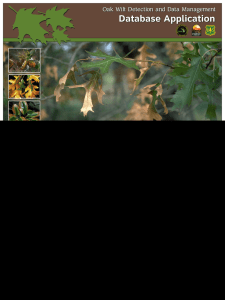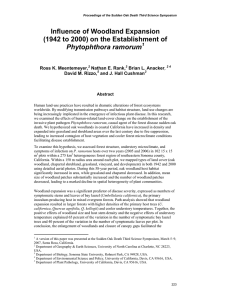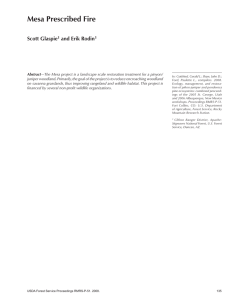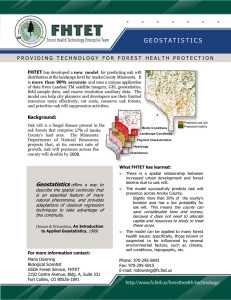Document 13726444
advertisement
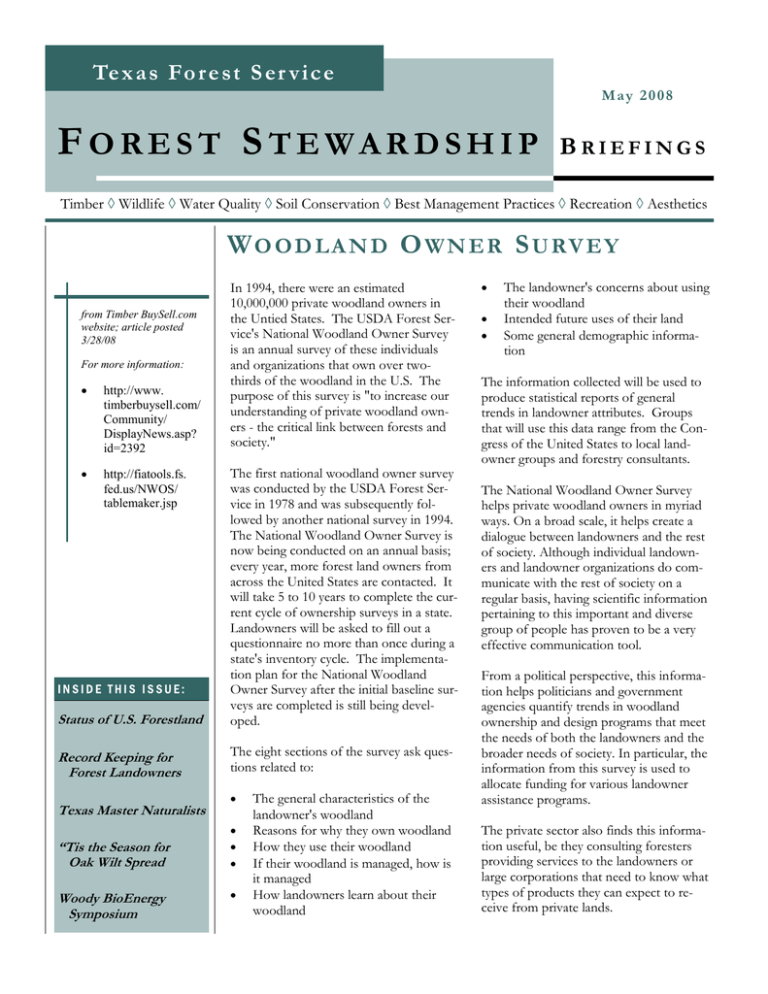
Te x a s Fo r e s t S e r v i c e May 2008 FOREST S TEWARDSHIP BRIEFINGS Timber ◊ Wildlife ◊ Water Quality ◊ Soil Conservation ◊ Best Management Practices ◊ Recreation ◊ Aesthetics W O O D L A N D O W N E R S U RV E Y from Timber BuySell.com website; article posted 3/28/08 For more information: • http://www. timberbuysell.com/ Community/ DisplayNews.asp? id=2392 • http://fiatools.fs. fed.us/NWOS/ tablemaker.jsp In 1994, there were an estimated 10,000,000 private woodland owners in the Untied States. The USDA Forest Service's National Woodland Owner Survey is an annual survey of these individuals and organizations that own over twothirds of the woodland in the U.S. The purpose of this survey is "to increase our understanding of private woodland owners - the critical link between forests and society." Status of U.S. Forestland The first national woodland owner survey was conducted by the USDA Forest Service in 1978 and was subsequently followed by another national survey in 1994. The National Woodland Owner Survey is now being conducted on an annual basis; every year, more forest land owners from across the United States are contacted. It will take 5 to 10 years to complete the current cycle of ownership surveys in a state. Landowners will be asked to fill out a questionnaire no more than once during a state's inventory cycle. The implementation plan for the National Woodland Owner Survey after the initial baseline surveys are completed is still being developed. Record Keeping for Forest Landowners The eight sections of the survey ask questions related to: INSIDE THIS ISSUE: Texas Master Naturalists “Tis the Season for Oak Wilt Spread Woody BioEnergy Symposium • • • • • The general characteristics of the landowner's woodland Reasons for why they own woodland How they use their woodland If their woodland is managed, how is it managed How landowners learn about their woodland • • • The landowner's concerns about using their woodland Intended future uses of their land Some general demographic information The information collected will be used to produce statistical reports of general trends in landowner attributes. Groups that will use this data range from the Congress of the United States to local landowner groups and forestry consultants. The National Woodland Owner Survey helps private woodland owners in myriad ways. On a broad scale, it helps create a dialogue between landowners and the rest of society. Although individual landowners and landowner organizations do communicate with the rest of society on a regular basis, having scientific information pertaining to this important and diverse group of people has proven to be a very effective communication tool. From a political perspective, this information helps politicians and government agencies quantify trends in woodland ownership and design programs that meet the needs of both the landowners and the broader needs of society. In particular, the information from this survey is used to allocate funding for various landowner assistance programs. The private sector also finds this information useful, be they consulting foresters providing services to the landowners or large corporations that need to know what types of products they can expect to receive from private lands. P ag e 2 Te x a s F o re s t S e r v i ce S TA T U S from “Forests & People,” official publication of the Louisiana Forestry Association; Vol. 58 No. 2; First Quarter 2008 OF U. S . F O R E S T L A N D The most recent USDA Forest Service data confirms that U.S. forestland is roughly as abundant today as it was 100 years ago. The Forest Service’s Resource Planning Act 2007 (RPA data) reveals both state and regional increases in forestland across the country. report by the Society of American Foresters (SAF), which found that replanting and reforestation efforts, as well as natural forest re-growth on abandoned agricultural lands, have generally offset any loss of forestland during the 20th century due to urban/suburban growth. Among the key findings in the report are: • There are 750 million acres of forestland in the U.S. today, about the same as in 1907. • Eleven states had increases of over 25% over the last century, and nine had increases of over 30%. • Overall, forestland in the northern U. S. has increased by almost 30%. • The United States ranks fourth on the list of most forest-rich countries, following the Russian Federation, Brazil and Canada. Historical trends indicate that the standing inventory (volume of growing trees) of hardwood and softwood tree species in U. S. forests increased by 49% between 1953 and 2006. For more information: • http://www.fia.fs. fed.us/programfeatures/rpa/default. asp • http://safnet.org/ aboutforestry/index. cfm This encouraging data is provided by the Forest Service’s Forest Inventory and Analysis (FIA) National Program. On the state level, statistics show: • Virginia, South Carolina, Tennessee, Kentucky, and Louisiana have more forestland today than a century ago. • Over the same period of time, forestland in Vermont, Pennsylvania and North Dakota has almost doubled. • Forestland in Massachusetts and New York has shown an increase of over 70%. The new data reinforces findings in a 2007 RECORD KEEPING from Timber BuySell.com website; article posted 4/6/08 For more information: • http:// timberbuysell.com/ Community/ DisplayNews.asp? id=2426 FOR Forest landowners should keep records of activities on their forestlands. Accurate, complete and well-organized records are important for a number of reasons but especially for reporting forest management expenses and revenues for income tax purposes. A publication called “Keeping Records of For the past 50 years, tree removals have remained below 2% of standing inventory (the figure for 2006 was 1.68%). Meanwhile, the net growth of trees has been near 3% (in 2006, 2.64%). It is also noted that the stability and abundance of forestland, together with the growing conservation ethic of the American public over the past century, has helped many species on the brink of extinction (e.g., wild turkey, elk) make full recoveries. The report notes significant challenges such as fire, insects and disease, invasive weeds, unmanaged recreation, and land conversions. The report reinforces the importance of continuing sustainable forest practices to insure forestland remains abundant for generations to come. FOREST LANDOWNERS Forest Management Activities” is primarily for landowners whose main source of income is not from the forested property. It introduces you to record keeping, what to record and simple recording systems. To download this 12-page booklet, go to http://smallwoodnews.com/Docs/PDF/ Landowner/ForestryFinance.pdf. F o r es t S t e w ar d sh i p B ri e f i n g s P ag e 3 TEXAS MASTER NATURALISTS The Texas Master Naturalist program activities are coordinated and funded by AgriLife Extension and Texas Parks and Wildlife. It is a venture directed toward developing local corps of "master volunteers" to provide education, outreach, and service dedicated to the beneficial management of natural resources and natural areas within their communities. training, and completing 40 hours of volunteer service. To retain the Texas Master Naturalist title during each subsequent year, volunteers must complete 8 additional hours of advanced training and provide an additional 40 hours of volunteer service coordinated through their local chapter. Check for local chapters near you on the website in the sidebar. An individual gains the designation of Texas Master Naturalist™ after participating in an approved chapter training program with a minimum of 40 hours of combined field and classroom instruction, obtaining 8 hours of approved advanced Many communities and organizations rely on such citizen volunteers for implementing youth education programs; for operating parks, nature centers, and natural areas; and for providing leadership in local natural resource conservation efforts. ‘TIS THE SEASON FOR For more information: • http://grovesite. com/page.asp? o=tmn&s=MN&p= 210150 OAK WILT SPREAD Spring has arrived, and with its dazzling display of color and growth come the sapfeeding beetles that can spread oak wilt and cause death and destruction during this time. Understanding the oak wilt life cycle is important in preventing new infections from this fungal disease. tion in spring makes this time of year the wrong time for oak pruning. The long standing recommendations to avoid pruning or injuring oaks from February to June and to paint oak wounds year-round tie directly to the life cycle of the oak wilt pathogen. In mid March, Texas Forest Service foresters and arborists begin identifying red oaks that have succumbed to the oak wilt fungus. Some of these diseased trees will form fungal mats, a mushroom-like structure just under the bark. These sweet smelling mats attract sap feeding beetles, which, after feeding on the fungal mats, fly away covered with diseased spores seeking their next meal of tree sap. If they happen to feed from a wound on an oak, the spores can dislodge, germinate and infect the new oak – and the neighborhood. This is the beginning of a new oak wilt disease center. Equally important to stopping the spread of the disease is the eradication of oak wilt stricken red oaks, especially those that have died during the fall months. These trees generally do not dry out over winter and often harbor the fungus until springtime, when fungal mats begin forming. It is important for communities dealing with oak wilt to monitor the health of red oaks in the immediate area adjoining oak wilt disease centers. Red oaks can contract the disease from nearby live oaks via root grafts much in the same way that live oaks share the disease with each other. If a red oak contracts oak wilt, there is potential for fungal mat formation and long distance spread of this disease. In Texas, fungal mats can form on diseased red oaks from February through May. Sap beetle activity, and thus dispersal of fungal spores, is also at its peak during this time of year. Add to the equation the oaks being more susceptible to infec- from the Texas Master Naturalist website For additional information about preventing oak wilt spread, or to contact a professional about oak wilt in your neighborhood, go to www.texasoakwilt.org. by Eric Beckers, Staff Forester, Texas Forest Service, Austin, TX For more information: • http://www. texasoakwilt.org • http:// texasforestservice. tamu.edu/main/ article.aspx? id=1172 • http:// texasforestservice. tamu.edu/main/ article.aspx? id=1173 Distribution of this newsletter is provided free of charge to professional foresters, state and federal agency professionals, county judges and commissioners, state senators and representatives, various forestry-related associations, and others. PLEASE ADVISE US IF YOU WISH YOUR NAME REMOVED FROM OUR MAILING LIST. This newsletter is also available on the web at http:// texasforestservice.tamu.edu/main/article.aspx? id=1183. If you would rather receive this newsletter electronically (by e-mail) or if you would like e-mail notification when a new issue is available at our web site, contact us at the address, phone number or email address above. The Texas Forest Service is an Affirmative Action/Equal Opportunity Employer committed to Excellence through Diversity. Editorial Board • Rusty Wood, TPWD, Nacogdoches, Texas • Joe Pase, TFS, Lufkin, Texas WOODY BIOENERGY SYMPOSIUM Northeast Texas Woody BioEnergy Symposium June 4-6, 2008 Jefferson Institute in Jefferson, Texas Something for everyone: June 4 - Sustainable Forestry for Bio-Energy and Bio-Based Products Training for Natural Resource Professionals June 5 & 6 - East Texas Woody Bio-Energy Community Development Conference June 6 (evening) - Woody Bio-Energy Opportunities for Landowners For more information, contact Brock A. Fry, Marion County Extension Agent-Agriculture/Natural Resources: Phone: (903) 665-2421 E-mail: bafry@ag.tamu.edu For agenda, go to: http://grovesite.com/page.asp?o=tamu&s=ntbs&p=261992 P. O. Box 310 Lufkin, TX 75902-0310 Phone: 936-639-8180 Email: dwork@tfs.tamu.edu TDD Line: 1-866-419-4872

